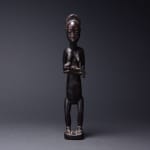Baule Sculpture of a Mother and Child, 20th Century CE
Wood
41.3 x 8.3 cm
16 1/4 x 3 1/4 in
16 1/4 x 3 1/4 in
PF.3571
Further images
One of the Akan peoples who inhabited an area of southern Ghana, the Baule probably migrated west to their present home in the Ivory Coast more than two hundred years...
One of the Akan peoples who inhabited an area of southern Ghana, the Baule probably migrated west to their present home in the Ivory Coast more than two hundred years ago. Baule figural sculpture is distinctive for its graceful beauty and the virtuosity of its carving. Baule figures function in two principle ways: as the adobe of a nature spirit before whom sacrifices are made, or as a representation of one's spouse in the spirit world, whose image must be enshrined and attended.
This skillfully carved and polished wooden sculpture glows with its beauty and grace. Depicting an image of a standing female figure nursing a baby, the sculptural attributes of the figure denote the important idea of fertility, birth, and life. Her soft, oval-shaped face, neatly arranged hair, and her gentle facial features bring her feminine beauty alive. The soft curves of her body and her breasts also accentuate her life-giving motherhood. In Ancient Africa, the concept of life was considered very crucial and was cherished. Many rituals' and ceremonies' themes revolved around the idea and figures of mother-goddess often appear in their art. Possibly enshrined for ritual purposes, this beautiful sculpture was maybe used in wishing for fertility. Decorated with intricate representation of scarification marks, this figure is a fine example of graceful Baule sculpture.
This skillfully carved and polished wooden sculpture glows with its beauty and grace. Depicting an image of a standing female figure nursing a baby, the sculptural attributes of the figure denote the important idea of fertility, birth, and life. Her soft, oval-shaped face, neatly arranged hair, and her gentle facial features bring her feminine beauty alive. The soft curves of her body and her breasts also accentuate her life-giving motherhood. In Ancient Africa, the concept of life was considered very crucial and was cherished. Many rituals' and ceremonies' themes revolved around the idea and figures of mother-goddess often appear in their art. Possibly enshrined for ritual purposes, this beautiful sculpture was maybe used in wishing for fertility. Decorated with intricate representation of scarification marks, this figure is a fine example of graceful Baule sculpture.









